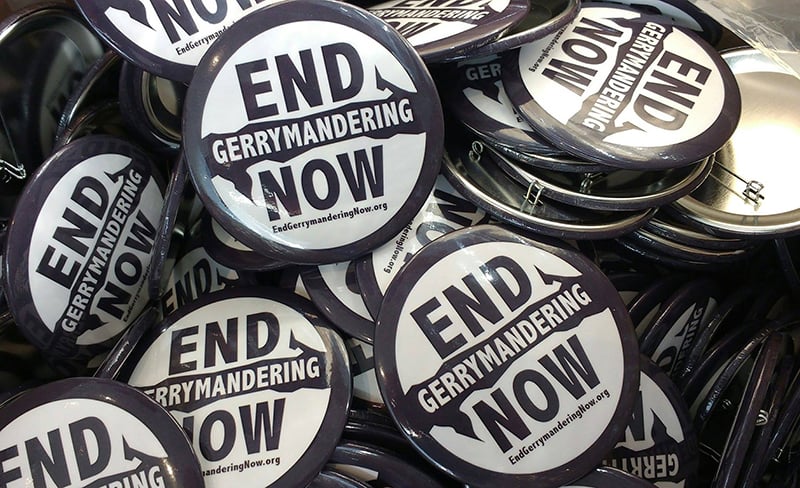A Guide To North Carolina’s Gerrymandering
North Carolina is one of the nation’s most gerrymandered states. Here’s what to know and what you can do

Kate Barr’s quixotic run for a state Senate seat reflects a hard reality for North Carolina voters: For the past 15 years, the Republican-controlled General Assembly has drawn and redrawn congressional and legislative district lines to secure partisan advantage, and the result is one of the most gerrymandered states in America.
That’s not to say Democrats didn’t do it, too, when they held legislative power, as they did for more than a century before the 2010 elections. Experts like Bob Phillips, the executive director of Common Cause North Carolina, say mapping technology allows lawmakers to draw lines with a precision that surpasses what was possible before, and Republicans here have simply taken advantage. But even in a starkly divided nation and state, gerrymandering is a bipartisan issue.
“I’ve been at Common Cause for 25 years, and I stood shoulder-to-shoulder with Republicans in the aughts, calling for redistricting reform when the Democrats were doing it,” Phillips says. “It’s always about bad actors who are in power doing the gerrymandering deed to entrench their power. It is as simple as that, and North Carolina is the poster child for it, unfortunately. Until we have something that is different from lawmakers drawing their own districts, we’re going to be plagued by gerrymandering.”
Common Cause is a national nonprofit that advocates for accountable and open government, and gerrymandering is one of its most prominent issues. But it’s a complicated one—trying to keep up with multiple maps, lines, lawsuits, court rulings, and who represents what can make even the most civic-minded voters go cross-eyed. Here, according to Phillips, are the main things you should know.

Bob Phillips, the executive director of Common Cause North Carolina, speaks at a rally on State Capitol grounds in 2023.
1. It’s not fair.
“Gerrymandering is unfair to everyone—Republican, Democratic, and unaffiliated voters—because it preordains the districts to the point where we know who’s going to win. There are fewer and fewer competitive districts, and when you have that, it’s bad for everybody. Candidates cannot be held accountable because they are in districts that are safe. The media has nothing to cover because candidates really don’t have to do anything, so issues are suppressed. It’s bad for everybody, even the party in power, because your base voters are deciding who is going to be in office.”
2. It polarizes.
“When you have that, you have the extreme candidates, in general, who are then being elected, and whether they’re going to Congress or the North Carolina General Assembly, Democrats and Republicans are so far on either side of their own party, they have no incentive to compromise. In fact, if they do, they will be punished … which is a loss for everyone.”
3. It costs taxpayers money.
“It is terribly expensive. Millions of tax dollars go to defend (in court) the maps that the gerrymanderers, i.e., the lawmakers, draw.”
4. It undermines democracy.
“It also contributes to the erosion of confidence in our democracy. People just instinctively think, I don’t get it. What’s wrong? Why is it that there’s constantly something going on in court over maps, and the lines are changed? I think, overwhelmingly, people don’t know what the hell this is. … It just is another one of those aspects of what we have in North Carolina, that it corrodes the people’s confidence that we have a well-functioning democracy. I mean, it’s gaming the system. That’s all it is.”
What’s the solution?
“An independent redistricting commission: We’ve been advocating for that for years, and I know in Charlotte, you have former Governor Jim Martin and former Mayor Richard Vinroot, two high-profile Republicans who have certainly lent their names to the cause of redistricting reform over the years. The problem is, there’s no way to get an independent redistricting commission adopted here in North Carolina unless the legislature approves it. We’re not a ballot initiative state. The two states that have, in my opinion, some of the best examples of what an independent commission can do are Michigan and California, and both those states got that through a ballot initiative. In other words, it was put on the ballot, the people voted for it, and it passed. We can’t do that here. The legislature is the only body that can actually pass redistricting reform because the legislature is the body that decides what goes on a ballot.”
What can I do?
“The people really could be the main catalyst and instigator of reform if they simply speak out and talk to their lawmakers, and they say, ‘We’re not going to stand for it. We’re going to demand that you state where you are on this issue, and if you are saying to us you don’t like gerrymandering, then you demonstrate that by supporting redistricting reform.’ I mean, we could end it overnight, and all it would take is a bipartisan bill filed in the North Carolina General Assembly. If you put that bill before the people of North Carolina, it would overwhelmingly pass, and if the lawmakers voted the way their constituents wanted them to, they would have to pass it. It’s a lot for the people to understand, but the power is with the people, and if they really don’t like it, they’ve got to speak out.”
Where Did That Word Come From?
In short, Massachusetts and a man named Elbridge Gerry—with a hard “g.” He was the governor who, on Feb. 11, 1812, signed into law a reapportionment bill that redrew state Senate voting district lines to favor his Jeffersonian Republican Party. The opposing Federalist Party cried foul, and a Boston artist and engraver, Elkanah Tisdale, produced a cartoon that ran in the Boston Gazette on March 26, 1812. It showed “a new species of monster,” a rendering of an imaginary salamander based on the twisted shape of a district in Essex County: “The Gerry-Mander.”
The cartoon was shared widely, contributing to Gerry’s re-election defeat that year. But he ended up on the national ticket as President James Madison’s running mate. Gerry was vice president from March 1813 to November 1814, when he died of a heart attack at 70. He was a signer of the Declaration of Independence, an actual Founding Father. But his lasting contribution to his country was the term we still use for a specific kind of political dirty pool.






